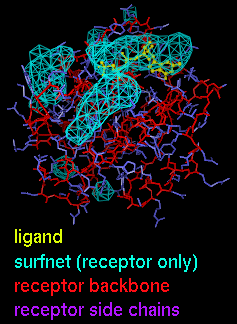Surfnet 
Surfnet finds and displays molecular cavities and indentations.
The method is an adaptation of that described in:
R.A. Laskowski,
"SURFNET: A program for visualizing molecular surfaces, cavities, and
intermolecular interactions" J Mol Graph 13:323 (1995).
See also:
Measure Volume and Area,
Measure and Color Blobs
There are several ways to start
Surfnet, a tool in the Surface/Binding Analysis category.
Surfnet comes in two flavors:
- Surfnet - Interface - find cavities between two
specified sets of atoms,
Receptor and Ligands. The two sets of atoms
do not really have to be a receptor and ligand(s).
They can be in the same or different models.
- Surfnet - Selected Atoms - find any cavities formed by
the specified atoms (the Midas Selection).
A brief description of the method is needed to explain the remaining options:
- Pairwise combinations of atoms are examined for intervening
void space. If the type of calculation is Interface,
only pairs with one atom from each specified set are examined.
If the type of calculation is Selected Atoms,
pairwise combinations of atoms in the specified set are examined.
Either way, only pairs of atoms no farther apart than the
Distance Cutoff (in Å) are examined. A "gap
sphere" is placed directly between the two atoms and shrunk until it no
longer intersects the VDW surface of any atom.
Atomic radii are
assigned by Chimera based on inferred atom types.
Gap spheres with radii equal to or greater than the Grid Interval
are retained.
- The Density of each gap sphere is smeared out from its center
according to a Gaussian or Quadratic function such that the
value at its radius (100.0 in arbitrary units) is half the value at its
peak (200.0).
- At each point in a 3-dimensional grid with Grid Interval
spacing (in Å), only the largest density
contribution from a gap sphere is stored.
This is not necessarily the contribution from the nearest gap sphere center,
since the decrease in density with distance depends on radius.
- The grid values are used to generate a contour surface at the level
of 100.0, which is opened as a
SurfaceModel
in Chimera and shown in the specified Representation
(Mesh or solid Surface) and
Color
(default white). The surface can be closed (deleted) or hidden using the
Model Panel.
OK executes a Surfnet calculation
and dismisses the dialog. Apply runs the calculation
without closing the dialog; each successive click on Apply
will create and display another surface.
Close closes the dialog, and Help opens this
manual page in a browser window.
UCSF Computer Graphics Laboratory / January 2008


